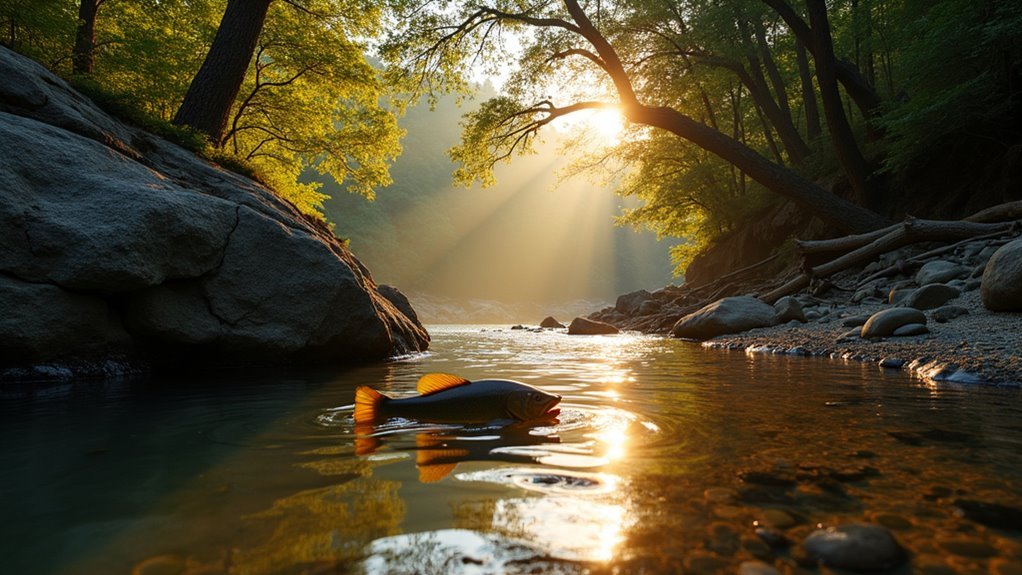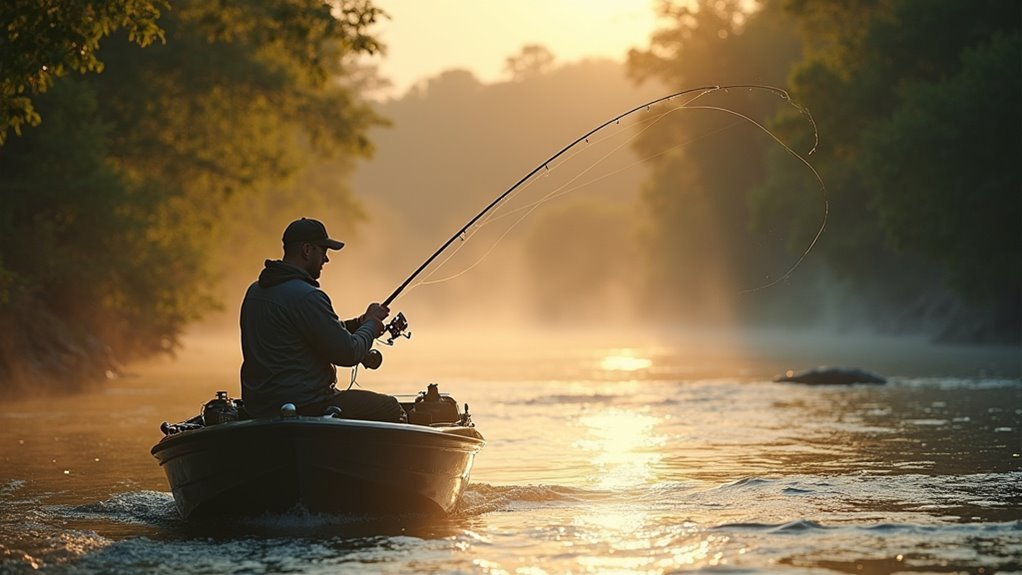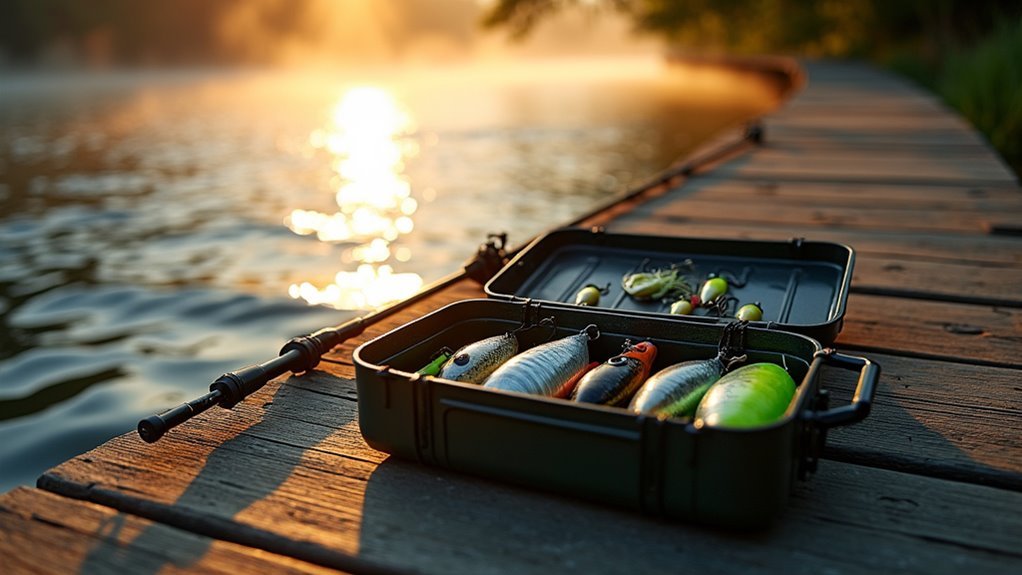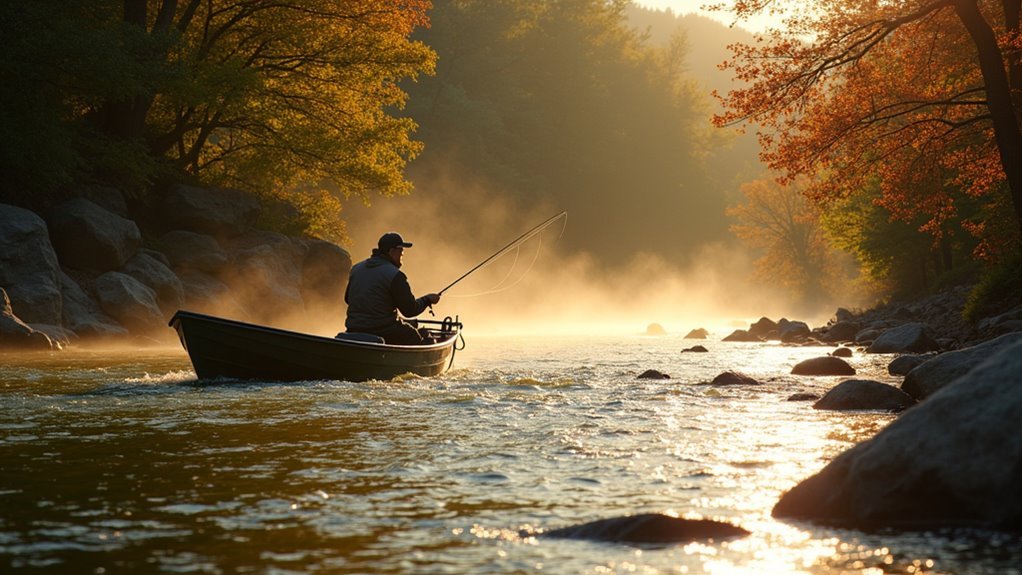To conquer river bass fishing today, we’ll need to target structure spots like brush piles, docks, and rock formations where bass hide. We can cast upstream and let lures drift into current breaks, adjusting our lure selection based on water clarity and conditions. In spring, we’ll find bass in protected backwaters, while summer heat pushes them to deeper holes. Always wear a life jacket and check water conditions before heading out. The secrets of the river await your next cast.
Understanding the Prime Bass Hideouts in Rivers

Four distinct hideouts make river bass fishing both challenging and rewarding. We’ve found that structure spots like brush piles, docks, and rock formations are bass magnets. Current breaks, where water flow changes direction, create perfect ambush points for these predators.
Don’t overlook holes in river bottoms! These deeper pockets give bass shelter from both current and overhead threats. Last summer, we hooked a 5-pounder in a hole that wasn’t bigger than a kiddie pool!
Finally, backwaters flooded by heavy rain are bass buffets. The fish move in to feed around submerged trees and vegetation. Their predictable nature in rivers makes finding these hideouts easier than on lakes. Additionally, understanding hydrodynamic forces and how they influence bass behavior can significantly enhance your fishing strategy.
Mastering Current-Based Fishing Techniques

When fishing in rivers with current, your technique needs to adapt to how bass position themselves in the flow. We’ve found that power fishing with moving baits works wonders when there’s a slight current. Cast upstream and let your lure drift naturally into current breaks where bass are waiting to ambush.
Remember to downsize for smallmouth and go bigger for largemouth. We once nailed a 5-pounder by bumping a jig against a submerged log during high water. Accuracy is everything! Target those current seams and structure precisely. In slower backwaters, switch to finesse presentations for those less aggressive bites. To enhance your fishing experience, consider optimizing your trolling motor efficiency to extend run times on the water.
Selecting the Perfect Lure Arsenal for River Bass

The right lure selection can make or break your river bass fishing success. We’ve caught hundreds of river bass over the years, and the right lure makes all the difference when those current-loving fish are being stubborn.
| Lure Type | When to Use | Target Areas |
|---|---|---|
| Spinnerbaits | Active fish, cloudy water | Current breaks, edges |
| Jigs | Slow days, clear water | Structure, holes |
| Crankbaits | Covering water, feeding fish | Channel ledges, rocks |
| Texas rigs | Heavy cover, backwaters | Flooded timber, vegetation |
Remember to match your colors to water clarity—natural tones for clear water, bright colors when it’s muddy.
Adapting to Seasonal Changes in River Bass Behavior

Having the right lures is just the first step—now we need to understand how bass behavior shifts throughout the year.
Bass are creatures of habit, yet they’re constantly adapting to their environment. In spring, they’ll head to spawning areas, often in protected backwaters. Summer heat pushes them to deeper holes seeking cooler refuge. Come fall, they’re feeding aggressively to bulk up for winter.
Water levels make a huge difference too. We’ve learned the hard way that high water pushes bass toward banks for breaks, while low water sends them deeper. Match your presentations to these patterns—power fishing in current, finesse in calm backwaters—and you’ll see results. Additionally, understanding the minimum thrust for freshwater motors needed based on your boat’s weight can enhance your fishing experience by ensuring reliable maneuverability in varying river conditions.
Targeting Specific Bass Species in River Environments

Did you know that various bass species behave differently in the same river? While largemouth and smallmouth bass often share the same waters, they require different approaches.
Smallmouths typically prefer faster currents, rocky structures, and deeper holes. We’ve found they respond best to smaller lures – downsizing can make a huge difference. They’re more aggressive fighters too!
Largemouths, meanwhile, gravitate toward backwaters, flooded timber, and slower current. They’ll hit larger lures and aren’t as spooked by heavier tackle.
When we’re targeting smallies specifically, we focus on clear water sections with good current. For largemouths, we seek out those quiet coves where the big girls hide.
Essential Safety Tips While Navigating River Systems
While enjoying the thrill of river bass fishing, we can’t overlook the importance of safety on moving water. The current is our biggest concern – I’ve seen it sweep anglers off their feet in seconds.
Always wear a life jacket, even if you’re just wading. Check water conditions before heading out, as rivers can change dramatically after rain. Watch for hidden hazards like submerged logs or rocks – I once tore my waders on an invisible stump!
Keep a whistle handy and tell someone your fishing location. Remember, no bass is worth risking your life. Stay alert, stay safe.
Frequently Asked Questions
How Do Tides Affect Bass Fishing in Coastal River Systems?
In coastal river systems, we’ve found tides considerably impact bass fishing. They affect water depth, current flow, and baitfish movement. We’ll have better luck fishing incoming tides when bass move to shallow feeding areas.
Can River Bass Be Effectively Caught at Night?
Boldly bucking by moonlight, river bass can definitely be caught at night. We’ve found they often move to shallower areas with structure, where we’ll use darker lures that create more vibration and movement.
What’s the Best River Bass Fishing Approach During Heavy Rain?
During heavy rain, we’ll focus on fishing backwaters where bass escape the stronger currents. We should use bright-colored lures and target areas near runoffs, where increased oxygen and food attract feeding bass.
How Does River Pollution Impact Bass Behavior and Location?
We’ve found that pollution forces bass to relocate to cleaner waters or deeper holes. They’ll also change feeding patterns, avoid certain structures, and show decreased activity in heavily polluted areas.
Are River Bass More Line-Shy Than Their Lake Counterparts?
We’ve found river bass are often less line-shy than lake bass because they face stronger currents and murkier water, making them more opportunistic when striking lures that come their way.
Conclusion
We’ve covered the essentials that’ll transform your river bass fishing game. Like a skilled chess player anticipating their opponent’s next move, you’ll now read water and predict bass behavior with confidence. River fishing rewards those who understand its patterns and respect its power. Remember, each flowing waterway holds its secrets—but armed with these strategies, you’re ready to reveal them all. Now get out there and tight lines to you!